Schedule
Tea Crop Schedule
| Product Name | Fertilizers | ||||||
|---|---|---|---|---|---|---|---|
| Poornima Kit | NPK Grow Caps |
Humigrow Nano Powder |
Alp | Sonha-Bihan | IBP Kit | ||
| Humic Acid | Chelated Multi-micronutrient |
PGP/PGR | |||||
| Vegetative Growth | January | 1 Kit | 1 Kit | ||||
| February | |||||||
| March | 2 Caps | 120gm | |||||
| April | 250gm | 250gm | |||||
| May | 1 Kit | 1 Kit | |||||
| June | |||||||
| July | |||||||
| August | 2 Caps | 120gm | 250gm | 250gm | |||
| September | 1 Kit | ||||||
| October | 1 Kit | ||||||
| November | 2 Caps | 120gm | |||||
| December | |||||||
| Harvesting | |||||||
| Total Quantity | 3 Kit | 6 Caps | 360gm | 500gm | 500gm | 3 Kit | |
| Broadcast | |
| Top Dressing | |
| Basal Dressing | |
| Soil Application | |
| Spray | |
| * | Optional |
NOTE: For the first year donot immidietaly substitute 100% chemical fertilizer with the SIESTO GREEN products, as the soil is used to chemical fertilizer, it may affect the output. So the best way to substitute is by reducing 50% of chemical input in the first year, 25% the following 2nd year, & then another 10% by the 3rd year. After the 3rd year use synthetic fertilizer / inorganic fertilizer if their is a requirement depending on the soil health.
CROP SCHEDULE FOR CABBAGE
Sr. No.Treatment / ApplicationProductDose /AcreAPPLICATIONManagement1Vegetative – Dissolve in 20 to 200 ltr. of water as required for 1 acre of land and apply through Drip Irrigation or drench.POORNIMA KIT1 KITApply it in the month of January, May & October.It is a balanced form of nutrients that includes NPK, Zinc, Cropforce NP, Humigrow NP, and Mycorrhiza NP2Vegetative – Mix all with the required amount of water and apply through drip irrigation, flood irrigation, or drenching as per farmer’s availability.NPK + Humigrow2caps + 120gmApply it in the month of March, August & November.It is a balanced form of Nutrition that includes NPK with Humic3Flowering – Mix it in 200 liters of water and spray it in the plants.ALP + Sonhabihan250gm + 250gm / 200 lit. of waterApply it in the month of April & AugustIt is a Micronutrient and PGP that helps in Growth, Fruit set, and the quality of the produce.4Soil Treatment – Mix it in the required amount of water & drench it near the plant roots.IBP Kit1 acre kitApply it in the month of January, May & September.It helps to control Soil-borne diseases, fungal attacks & in nematode control.
NOTE: For any kind of Deficiency, Pest attacks, or Fungal or Bacterial diseases use the products as suggested.
PEST ATTACKS, BACTERIAL, OR FUNGAL MANAGEMENT
PEST / BACTERIAL / FUNGAL
DAMAGE SYMPTOMS IN CROP
SYMPTOMS
SUGGESTED PRODUCT
Blister blight
 Small, pinhole-size spots are initially seen on young leaves less than a month old. As the leaves develop, the spots become transparent, larger, and light brown.
Indofa + Bacillus
Red Rust
Small, pinhole-size spots are initially seen on young leaves less than a month old. As the leaves develop, the spots become transparent, larger, and light brown.
Indofa + Bacillus
Red Rust
 Leaves develop lesions that are roughly circular, raised, and purple to reddish-brown. The alga may spread from leaves to branches and fruit.
Indofa
Brown Blight, Grey Blight
Leaves develop lesions that are roughly circular, raised, and purple to reddish-brown. The alga may spread from leaves to branches and fruit.
Indofa
Brown Blight, Grey Blight
 Small, oval, pale yellow-green spots first appear on young leaves. Often the spots are surrounded by a narrow, yellow zone.
Indofa
Twig Die Back, Stem Canker
Small, oval, pale yellow-green spots first appear on young leaves. Often the spots are surrounded by a narrow, yellow zone.
Indofa
Twig Die Back, Stem Canker
 The first symptoms include browning and drooping of affected leaves. As the disease spreads into the shoots, they become dry and die. The entire branch can die from the tip downward.
Indofa + Bacillus
Red Root Rot Disease
The first symptoms include browning and drooping of affected leaves. As the disease spreads into the shoots, they become dry and die. The entire branch can die from the tip downward.
Indofa + Bacillus
Red Root Rot Disease
 First symptoms appear as yellowing of the leaf followed by wilting and then the sudden death of the bush or entire bush with the weathered leaves attached to the stem for several days.
Indofa
Tea Mosquito Bug
First symptoms appear as yellowing of the leaf followed by wilting and then the sudden death of the bush or entire bush with the weathered leaves attached to the stem for several days.
Indofa
Tea Mosquito Bug
 The nymphs and adults suck the sap of the young leaves, buds, and tender stems and while doing so, they inject toxic saliva which causes the breakdown of tissues around the site of feeding.
Traps
Thrips
The nymphs and adults suck the sap of the young leaves, buds, and tender stems and while doing so, they inject toxic saliva which causes the breakdown of tissues around the site of feeding.
Traps
Thrips
 Feeds on tender above-ground parts, creating feeding scars, distortion of leaves, and discoloration of buds.
Lifeline + Traps + Meta + Pacliq
Leaf Eating Caterpillar
Feeds on tender above-ground parts, creating feeding scars, distortion of leaves, and discoloration of buds.
Lifeline + Traps + Meta + Pacliq
Leaf Eating Caterpillar
 In the early stages, the caterpillars are gregarious and scrape the chlorophyll content of leaf lamina giving it a papery white appearance. Later they become voracious feeders making irregular holes in the leaves.
BT
Jassid
In the early stages, the caterpillars are gregarious and scrape the chlorophyll content of leaf lamina giving it a papery white appearance. Later they become voracious feeders making irregular holes in the leaves.
BT
Jassid
 Both nymphs and adults suck the sap from the lower leaf surfaces through their piercing and sucking mouthparts. While sucking the plant sap, they also inject toxic saliva into the plant tissues, which leads to yellowing.
Lifeline
Aphids
Both nymphs and adults suck the sap from the lower leaf surfaces through their piercing and sucking mouthparts. While sucking the plant sap, they also inject toxic saliva into the plant tissues, which leads to yellowing.
Lifeline
Aphids
 Nymphs and adults suck cell sap from the plant foliage. In addition, plants may become contaminated by honeydew produced by aphids and sooty mold growing on honeydew.
Lifeline + Traps + Meta + BT
Bunch Caterpillar
Nymphs and adults suck cell sap from the plant foliage. In addition, plants may become contaminated by honeydew produced by aphids and sooty mold growing on honeydew.
Lifeline + Traps + Meta + BT
Bunch Caterpillar
 The damage is caused to the host plant by the caterpillars. The caterpillars eat the foliage of the host plant. Initially, they feed upon the surface tissues only but later on the whole blade is consumed.
BT
Red Spider Mite
The damage is caused to the host plant by the caterpillars. The caterpillars eat the foliage of the host plant. Initially, they feed upon the surface tissues only but later on the whole blade is consumed.
BT
Red Spider Mite
 Spider mites usually extract the cell contents from the leaves using their long, needlelike mouthparts. this results in reduced chlorophyll content in the leaves, leading to the formation of white or yellow speckles on the leaves.
Lifeline + Traps + Meta + BT
Purple Mite
Spider mites usually extract the cell contents from the leaves using their long, needlelike mouthparts. this results in reduced chlorophyll content in the leaves, leading to the formation of white or yellow speckles on the leaves.
Lifeline + Traps + Meta + BT
Purple Mite
 Damaged leaves are characterized by coppery brown discoloration; and the presence of numerous white cast skins of the mites along with the live mites; purple mites are prevalent on the undersurface of mature leaves.
BT + Bacillus
Yellow Mite
Damaged leaves are characterized by coppery brown discoloration; and the presence of numerous white cast skins of the mites along with the live mites; purple mites are prevalent on the undersurface of mature leaves.
BT + Bacillus
Yellow Mite
 Mite is seen on young leaves especially the top two to three leaves and the bud. Affected leaves become rough and brittle and have corky lines. Downward curling and internodes get shortened.
Lifeline + Traps + Meta + BT
Scarlet Mite
Mite is seen on young leaves especially the top two to three leaves and the bud. Affected leaves become rough and brittle and have corky lines. Downward curling and internodes get shortened.
Lifeline + Traps + Meta + BT
Scarlet Mite
 Symptoms of attack first appear on either side of the midrib and gradually spread to the entire leaf; feeding leads to brown discoloration of leaves and severe infestation leads to defoliation.
BT + Bacillus
Root Knot Nematode
Symptoms of attack first appear on either side of the midrib and gradually spread to the entire leaf; feeding leads to brown discoloration of leaves and severe infestation leads to defoliation.
BT + Bacillus
Root Knot Nematode
 Infected plants in patches in the field. The formation of galls on the host root system is the primary symptom.
Meta + BT + Pacliq
Infected plants in patches in the field. The formation of galls on the host root system is the primary symptom.
Meta + BT + Pacliq
 Small, pinhole-size spots are initially seen on young leaves less than a month old. As the leaves develop, the spots become transparent, larger, and light brown.
Indofa + Bacillus
Red Rust
Small, pinhole-size spots are initially seen on young leaves less than a month old. As the leaves develop, the spots become transparent, larger, and light brown.
Indofa + Bacillus
Red Rust
 Leaves develop lesions that are roughly circular, raised, and purple to reddish-brown. The alga may spread from leaves to branches and fruit.
Indofa
Brown Blight, Grey Blight
Leaves develop lesions that are roughly circular, raised, and purple to reddish-brown. The alga may spread from leaves to branches and fruit.
Indofa
Brown Blight, Grey Blight
 Small, oval, pale yellow-green spots first appear on young leaves. Often the spots are surrounded by a narrow, yellow zone.
Indofa
Twig Die Back, Stem Canker
Small, oval, pale yellow-green spots first appear on young leaves. Often the spots are surrounded by a narrow, yellow zone.
Indofa
Twig Die Back, Stem Canker
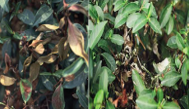 The first symptoms include browning and drooping of affected leaves. As the disease spreads into the shoots, they become dry and die. The entire branch can die from the tip downward.
Indofa + Bacillus
Red Root Rot Disease
The first symptoms include browning and drooping of affected leaves. As the disease spreads into the shoots, they become dry and die. The entire branch can die from the tip downward.
Indofa + Bacillus
Red Root Rot Disease
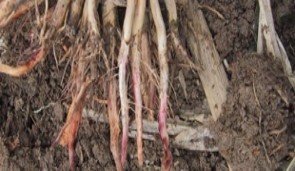 First symptoms appear as yellowing of the leaf followed by wilting and then the sudden death of the bush or entire bush with the weathered leaves attached to the stem for several days.
Indofa
Tea Mosquito Bug
First symptoms appear as yellowing of the leaf followed by wilting and then the sudden death of the bush or entire bush with the weathered leaves attached to the stem for several days.
Indofa
Tea Mosquito Bug
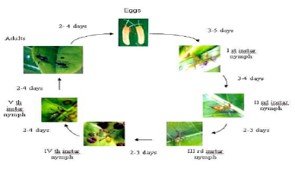 The nymphs and adults suck the sap of the young leaves, buds, and tender stems and while doing so, they inject toxic saliva which causes the breakdown of tissues around the site of feeding.
Traps
Thrips
The nymphs and adults suck the sap of the young leaves, buds, and tender stems and while doing so, they inject toxic saliva which causes the breakdown of tissues around the site of feeding.
Traps
Thrips
 Feeds on tender above-ground parts, creating feeding scars, distortion of leaves, and discoloration of buds.
Lifeline + Traps + Meta + Pacliq
Leaf Eating Caterpillar
Feeds on tender above-ground parts, creating feeding scars, distortion of leaves, and discoloration of buds.
Lifeline + Traps + Meta + Pacliq
Leaf Eating Caterpillar
 In the early stages, the caterpillars are gregarious and scrape the chlorophyll content of leaf lamina giving it a papery white appearance. Later they become voracious feeders making irregular holes in the leaves.
BT
Jassid
In the early stages, the caterpillars are gregarious and scrape the chlorophyll content of leaf lamina giving it a papery white appearance. Later they become voracious feeders making irregular holes in the leaves.
BT
Jassid
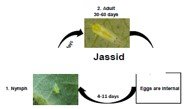 Both nymphs and adults suck the sap from the lower leaf surfaces through their piercing and sucking mouthparts. While sucking the plant sap, they also inject toxic saliva into the plant tissues, which leads to yellowing.
Lifeline
Aphids
Both nymphs and adults suck the sap from the lower leaf surfaces through their piercing and sucking mouthparts. While sucking the plant sap, they also inject toxic saliva into the plant tissues, which leads to yellowing.
Lifeline
Aphids
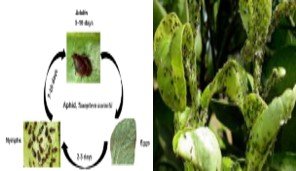 Nymphs and adults suck cell sap from the plant foliage. In addition, plants may become contaminated by honeydew produced by aphids and sooty mold growing on honeydew.
Lifeline + Traps + Meta + BT
Bunch Caterpillar
Nymphs and adults suck cell sap from the plant foliage. In addition, plants may become contaminated by honeydew produced by aphids and sooty mold growing on honeydew.
Lifeline + Traps + Meta + BT
Bunch Caterpillar
 The damage is caused to the host plant by the caterpillars. The caterpillars eat the foliage of the host plant. Initially, they feed upon the surface tissues only but later on the whole blade is consumed.
BT
Red Spider Mite
The damage is caused to the host plant by the caterpillars. The caterpillars eat the foliage of the host plant. Initially, they feed upon the surface tissues only but later on the whole blade is consumed.
BT
Red Spider Mite
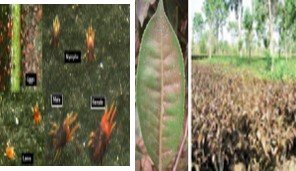 Spider mites usually extract the cell contents from the leaves using their long, needlelike mouthparts. this results in reduced chlorophyll content in the leaves, leading to the formation of white or yellow speckles on the leaves.
Lifeline + Traps + Meta + BT
Purple Mite
Spider mites usually extract the cell contents from the leaves using their long, needlelike mouthparts. this results in reduced chlorophyll content in the leaves, leading to the formation of white or yellow speckles on the leaves.
Lifeline + Traps + Meta + BT
Purple Mite
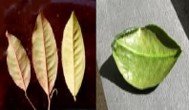 Damaged leaves are characterized by coppery brown discoloration; and the presence of numerous white cast skins of the mites along with the live mites; purple mites are prevalent on the undersurface of mature leaves.
BT + Bacillus
Yellow Mite
Damaged leaves are characterized by coppery brown discoloration; and the presence of numerous white cast skins of the mites along with the live mites; purple mites are prevalent on the undersurface of mature leaves.
BT + Bacillus
Yellow Mite
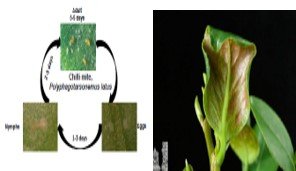 Mite is seen on young leaves especially the top two to three leaves and the bud. Affected leaves become rough and brittle and have corky lines. Downward curling and internodes get shortened.
Lifeline + Traps + Meta + BT
Scarlet Mite
Mite is seen on young leaves especially the top two to three leaves and the bud. Affected leaves become rough and brittle and have corky lines. Downward curling and internodes get shortened.
Lifeline + Traps + Meta + BT
Scarlet Mite
 Symptoms of attack first appear on either side of the midrib and gradually spread to the entire leaf; feeding leads to brown discoloration of leaves and severe infestation leads to defoliation.
BT + Bacillus
Root Knot Nematode
Symptoms of attack first appear on either side of the midrib and gradually spread to the entire leaf; feeding leads to brown discoloration of leaves and severe infestation leads to defoliation.
BT + Bacillus
Root Knot Nematode
 Infected plants in patches in the field. The formation of galls on the host root system is the primary symptom.
Meta + BT + Pacliq
Infected plants in patches in the field. The formation of galls on the host root system is the primary symptom.
Meta + BT + Pacliq
DISEASE CYCLE
Blister Blight
Rust

 Brown and Grey Blight
Twig Die Back, Stem Canker
Brown and Grey Blight
Twig Die Back, Stem Canker



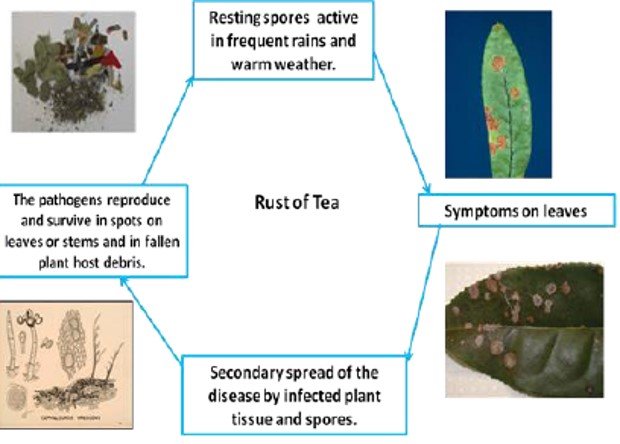 Brown and Grey Blight
Twig Die Back, Stem Canker
Brown and Grey Blight
Twig Die Back, Stem Canker

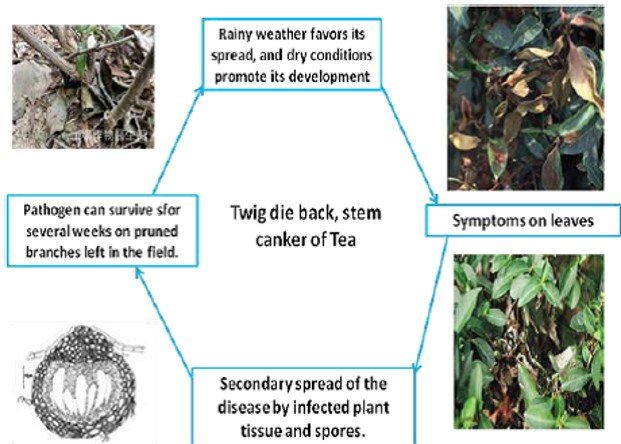
NUTRITION DEFICIENCY
NUTRIENTIDENTIFICATIONSYMPTOMSSUGGESTED PRODUCTNitrogen Yellowing of younger leaves. The leaves become rough, hard, and reduce in size.Azoto capsPotassium
Yellowing of younger leaves. The leaves become rough, hard, and reduce in size.Azoto capsPotassium Scorching due to chlorosis and necrosis occurs at the tip of the mature tea leaves and extends along the margin. Dominant purple/brown color and reduced leaf size are the common symptoms.Potash grow capsSulphur
Scorching due to chlorosis and necrosis occurs at the tip of the mature tea leaves and extends along the margin. Dominant purple/brown color and reduced leaf size are the common symptoms.Potash grow capsSulphur The characteristic symptom is 'Net veining' in the younger leaves where the leaf blade takes a striking yellow color and the veins down to the finest branching stand predominantly dark green.Sulphur Grow CapsZinc
The characteristic symptom is 'Net veining' in the younger leaves where the leaf blade takes a striking yellow color and the veins down to the finest branching stand predominantly dark green.Sulphur Grow CapsZinc The plants show very short internodes, chlorotic and small sickle-shaped leaves, and stunted auxiliary shoots.Zinc Grow caps
The plants show very short internodes, chlorotic and small sickle-shaped leaves, and stunted auxiliary shoots.Zinc Grow caps
 Yellowing of younger leaves. The leaves become rough, hard, and reduce in size.Azoto capsPotassium
Yellowing of younger leaves. The leaves become rough, hard, and reduce in size.Azoto capsPotassium Scorching due to chlorosis and necrosis occurs at the tip of the mature tea leaves and extends along the margin. Dominant purple/brown color and reduced leaf size are the common symptoms.Potash grow capsSulphur
Scorching due to chlorosis and necrosis occurs at the tip of the mature tea leaves and extends along the margin. Dominant purple/brown color and reduced leaf size are the common symptoms.Potash grow capsSulphur The characteristic symptom is 'Net veining' in the younger leaves where the leaf blade takes a striking yellow color and the veins down to the finest branching stand predominantly dark green.Sulphur Grow CapsZinc
The characteristic symptom is 'Net veining' in the younger leaves where the leaf blade takes a striking yellow color and the veins down to the finest branching stand predominantly dark green.Sulphur Grow CapsZinc The plants show very short internodes, chlorotic and small sickle-shaped leaves, and stunted auxiliary shoots.Zinc Grow caps
The plants show very short internodes, chlorotic and small sickle-shaped leaves, and stunted auxiliary shoots.Zinc Grow caps
PRECAUTIONS: -
Biofertilizer is not a chemical fertilizer hence do not mix with agrochemicals.Do not expose to direct sunlight or heat.Use Bio-fertilizer before or after 3-4 days of use of chemical fertilizer.Please, clean the sprayer before the use of Bio-fertilizer or bio-pesticide.

